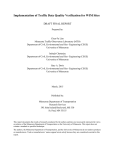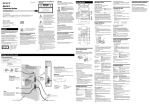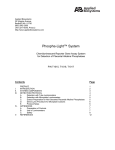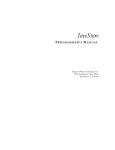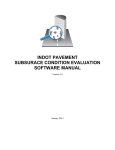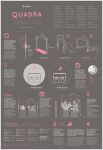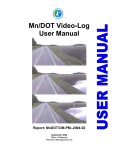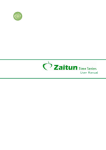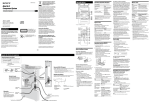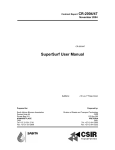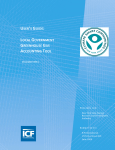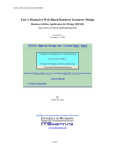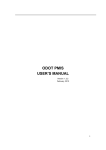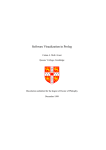Download Implementation of Traffic Data Quality Verification for WIM Sites
Transcript
Implementation of Traffic Data Quality Verification for WIM Sites Chen-Fu Liao, Principal Investigator Minnesota Traffic Observatory Department of Civil, Environmental, and Geo-Engineering University of Minnesota May 2015 Research Project Final Report 2015-18 To request this document in an alternative format call 651-366-4718 or 1-800-657-3774 (Greater Minnesota) or email your request to [email protected]. Please request at least one week in advance. Technical Report Documentation Page 1. Report No. 2. 3. Recipients Accession No. MN/RC 2015-18 4. Title and Subtitle 5. Report Date Implementation of Traffic Data Quality Verification for WIM Sites May 2015 7. Author(s) 8. Performing Organization Report No. 6. Chen-Fu Liao, Indrajit Chatterjee, and Gary A. Davis 9. Performing Organization Name and Address 10. Project/Task/Work Unit No. Department of Civil, Environmental and Geo- Engineering University of Minnesota 500 Pillsbury Drive, SE Minneapolis, MN 55455 CTS Project # 2014027 12. Sponsoring Organization Name and Address 13. Type of Report and Period Covered Minnesota Department of Transportation Research Services & Library 395 John Ireland Boulevard, MS 330 St. Paul, MN 55155 Final Report 11. Contract (C) or Grant (G) No. (c) 99008 (wo) 133 14. Sponsoring Agency Code 15. Supplementary Notes http://www.lrrb.org/pdf/201518.pdf 16. Abstract (Limit: 250 words) Weigh-In-Motion (WIM) system tends to go out of calibration from time to time, as a result generate biased and inaccurate measurements. Several external factors such as vehicle speed, weather, pavement conditions, etc. can be attributed to such anomaly. To overcome this problem, a statistical quality control technique is warranted that would provide the WIM operator with some guidelines whenever the system tends to go out of calibration. A mixture modeling technique using Expectation Maximization (EM) algorithm was implemented to divide the Gross Vehicle Weight (GVW) measurements of vehicle class 9 into three components, (unloaded, partially loaded, and fully loaded). Cumulative Sum (CUSUM) statistical process technique was used to identify any abrupt change in mean level of GVW measurements. Special attention was given to the presence of auto-correlation in the data by fitting an auto-regressive time series model and then performing CUSUM analysis on the fitted residuals. A data analysis software tool was developed to perform EM Fitting and CUSUM analyses. The EM analysis takes monthly WIM raw data and estimates the mean and deviations of GVW of class 9 fully loaded trucks. Results of the EM analyses are stored in a file directory for CUSUM analysis. Output from the CUSUM analysis will indicate whether there is any sensor drift during the analysis period. Results from the analysis suggest that the proposed methodology is able to estimate a shift in the WIM sensor accurately and also indicate the time point when the WIM system went out-of-calibration. A data analysis software tool, WIM Data Analyst, was developed using the Microsoft Visual Studio software development package based on the Microsoft Windows® .NET framework. An open source software tool called R.NET was integrated into the Microsoft .NET framework to interface with the R software which is another open source software package for statistical computing and analysis. 17. Document Analysis/Descriptors 18. Availability Statement Weigh in motion scales, Quality control, Calibration, Cumulative Sum (CUSUM), Statistical quality control No restrictions. Document available from: National Technical Information Services, Alexandria, Virginia 22312 19. Security Class (this report) 20. Security Class (this page) 21. No. of Pages Unclassified Unclassified 68 22. Price Implementation of Traffic Data Quality Verification for WIM Sites Final Report Prepared by: Chen-Fu Liao Indrajit Chatterjee Gary A. Davis Department of Civil, Environmental and Geo- Engineering Minnesota Traffic Observatory Laboratory University of Minnesota May 2015 Published by: Minnesota Department of Transportation Research Services & Library 395 John Ireland Boulevard, MS 330 St. Paul, MN 55155 This report documents the results of research conducted by the authors and does not necessarily represent the views or policies of the Minnesota Department of Transportation or the University of Minnesota. This report does not contain a standard or specified technique. The authors, the Minnesota Department of Transportation, and the University of Minnesota do not endorse products or manufacturers. Trade or manufacturers’ names appear herein solely because they are considered essential to this report. ACKNOWLEDGMENTS This project is sponsored by the Minnesota Department of Transportation (MnDOT). We would like to acknowledge MnDOT staff and engineers for their invaluable support and providing Weigh-In-Motion (WIM) data. We also thank members of the technical advisory panel (TAP) and the following individuals and organizations for their invaluable feedback and assistance in making this study possible. • • • • • • • • Benjamin Timerson (technical liaison) – MnDOT Joshua Kuhn – MnDOT Gregory Wentz – MnDOT Susan Anderson – MnDOT Alan Rindels (administration liaison) – MnDOT Nelson Cruz (administration liaison) – MnDOT Minnesota Traffic Observatory, Department of Civil, Environmental and Geo- Engineering (CEGE), University of Minnesota Center for Transportation Studies (CTS), University of Minnesota TABLE OF CONTENTS Chapter 1 INTRODUCTION .................................................................................................................... 1 1.1 Background ...............................................................................................................................................1 1.2 Objectives ..................................................................................................................................................1 1.3 Literature Review ......................................................................................................................................1 1.4 Report Organization ..................................................................................................................................3 Chapter 2 WIM DATA MODELING AND ANALYSIS ........................................................................ 4 2.1 Mixture Model...........................................................................................................................................4 2.2 Simulation Based Analysis ........................................................................................................................4 2.3 Analysis for WIM Measurements .............................................................................................................8 2.3.1 Case I: Station# 26, Lane # 3, Period: From 01/21/2011 to 01/23/2012 ................................ 10 2.3.2 Case II: Station# 29, Lane# 1, Period: 10/06/2010 to 06/17/2011 ......................................... 14 2.3.3 Case III: Station# 37, Lane# 2, Period: 11/29/2011 to 05/21/2012 ........................................ 16 2.3.4 Case IV: Station# 26, Lane # 4, Period: From 01/25/2012 to 01/28/2013 ............................. 19 2.3.5 Case Analysis Summary ........................................................................................................ 22 2.4 External Impacts on Truck Weights ........................................................................................................ 23 2.5 Impact of External Factors on GVW Estimates: Simulation Study ......................................................... 25 Chapter 3 DEVELOPMENT AND IMPLEMENTATION .................................................................. 30 3.1 Software Implementation Guidelines ...................................................................................................... 30 3.2 WIM Data Analyst Tool .......................................................................................................................... 31 3.3 Verification Using Simulated Scenarios.................................................................................................. 35 Chapter 4 WIM Data ANALYST User’s Manual.................................................................................. 40 4.1 Getting Started......................................................................................................................................... 41 4.1.1 Systems Requirements ........................................................................................................... 41 4.1.2 Installation Guide ................................................................................................................... 41 4.1.3 Technical Support .................................................................................................................. 41 4.2 Tutorial .................................................................................................................................................... 42 4.2.1 Set Working Directory ........................................................................................................... 42 4.2.2 Menu Bar ............................................................................................................................... 43 4.2.3 EM Fitting .............................................................................................................................. 44 4.2.4 CUSUM Analysis .................................................................................................................. 45 Chapter 5 SUMMARY AND CONCLUSION ....................................................................................... 50 REFERENCES .......................................................................................................................................... 51 Appendix A LIST OF FIGURES Figure 1: Simulated AR 1 process with mean=80 kips ..................................................................................................5 Figure 2: CUSUM based decision interval for AR (1) residuals ...................................................................................6 Figure 3: Residuals after fitting a non-stationary AR (1) process .................................................................................7 Figure 4: CUSUM plot for AR (1) residual ...................................................................................................................7 Figure 5: CUSUM based decision interval for AR (1) residual with change in mean ...................................................8 Figure 6: GVW for average daily fully loaded trucks, station 26: Case I .................................................................... 10 Figure 7: CF and PACF plots for Case I ...................................................................................................................... 11 Figure 8: Fitting learning sample: Case I..................................................................................................................... 12 Figure 9: Comparison between estimated and observed testing sample: Case I .......................................................... 13 Figure 10: CUSUM based decision plots for Case I .................................................................................................... 13 Figure 11: GVW for average daily fully loaded trucks, station 29: Case II ................................................................ 14 Figure 12: Fitting learning sample: Case II ................................................................................................................. 15 Figure 13: Comparison between estimated and observed testing sample: Case II ...................................................... 15 Figure 14: CUSUM based decision plots for Case II................................................................................................... 16 Figure 15: GVW for average daily fully loaded trucks, station 37: Case III ............................................................... 17 Figure 16: Fitting learning sample: Case III ................................................................................................................ 18 Figure 17: Comparison between estimated and observed testing sample: Case III ..................................................... 18 Figure 18: CUSUM based decision plots for Case III ................................................................................................. 19 Figure 19: GVW for average daily fully loaded trucks, station 26: Case IV ............................................................... 20 Figure 20: Fitting learning sample: Case IV ................................................................................................................ 21 Figure 21: Comparison between estimated and observed testing sample: Case IV ..................................................... 21 Figure 22: CUSUM based decision plots for Case IV ................................................................................................. 22 Figure 23: Inconsistent GVWs for fully loaded trucks from Station #26 (Lane 4)...................................................... 23 Figure 24: Inconsistent GVWs for fully loaded trucks from Station #37 .................................................................... 24 Figure 25: Inconsistent GVWs for fully loaded trucks from Station #32 .................................................................... 24 Figure 26: Inconsistent GVWs for fully loaded trucks from Station #26 (Lane 1)...................................................... 25 Figure 27: Simulated GVWs with WIM shift followed by an unstable GVW pattern ................................................ 26 Figure 28: Fitted learning sample ................................................................................................................................ 27 Figure 29: Predictions on testing sample I................................................................................................................... 27 Figure 30: CUSUM based decision interval for testing sample I ................................................................................ 28 Figure 31: CUSUM Analysis indicating unstable truck population ............................................................................ 29 Figure 32: WIM data analyst main screen ................................................................................................................... 31 Figure 33: Implementation guideline for CUSUM based algorithm for WIM calibration .......................................... 31 Figure 34: Flowchart of the WIM data analysis software ............................................................................................ 32 Figure 35: User interface of EM analysis .................................................................................................................... 33 Figure 36: User interface of CUSUM analysis ............................................................................................................ 33 Figure 37: CUSUM graph ........................................................................................................................................... 34 Figure 38: CUSUM DI graph ...................................................................................................................................... 35 Figure 39: Simulated AR (1) process with change in mean level ................................................................................ 36 Figure 40: Predictions on testing sample (t=61 to 90) ................................................................................................. 37 Figure 41: Predictions on testing sample (t=91 to 120) ............................................................................................... 37 Figure 42: CUSUM analysis on testing sample (t=91 to 120) ..................................................................................... 38 Figure 43: Predictions on testing sample (t=93 to 150) ............................................................................................... 38 Figure 44: Welcome page of the WIM data analyst software help document ............................................................. 40 Figure 45: Main screen of the WIM data analyst tool ................................................................................................. 42 Figure 46: Illustration of a selected working directory ................................................................................................ 42 Figure 47: File menu bar ............................................................................................................................................. 43 Figure 48: Sample of WIM calibration log table ......................................................................................................... 44 Figure 49: EM fitting screen ........................................................................................................................................ 45 Figure 50: CUSUM analysis screen............................................................................................................................. 46 Figure 51: Illustration of selecting dates, learning and testing periods........................................................................ 47 Figure 52: Sample GVW9 plot .................................................................................................................................... 47 Figure 53: Sample stationarity test results ................................................................................................................... 48 Figure 54: Sample results from a CUSUM analysis .................................................................................................... 48 Figure 55: Weekly GVW9 plot of WIM 34 ................................................................................................................. 49 LIST OF TABLES Table 1: Estimated AR (1) parameters for simulated data .............................................................................................5 Table 2 Estimated AR (1) parameters for learning sample: Case I.............................................................................. 11 Table 3 Estimated AR (1) parameters for learning sample: Case II ............................................................................ 14 Table 4 Estimated AR (1) parameters for learning sample: Case III ........................................................................... 17 Table 5 Estimated AR (1) parameters for learning sample: Case IV ........................................................................... 20 Table 6 Estimated AR (1) parameters for learning sample .......................................................................................... 26 Table 7 Estimated parameters from the learning sample ............................................................................................. 36 LIST OF ACRONYMS AND ABBREVIATIONS AADT AADTT AASHTO ACF AL AR ARL ASTM ATR CDF CEGE CI CPU CSV CTS CUSUM DI EM ESAL FHWA ft FXS FXW GIS GPS GUI GVW HTML IDE IRD ITS kips KPSS LTPP MnDOT MTO MUTCD NCHRP OS PACF RITA Annual Average Daily Traffic Annual Average Daily Truck Traffic American Association of State Highway and Transportation Officials Auto-Correlation Function Administration Liaison Auto Regression Average Run Length American Society for Testing and Materials Automatic Traffic Recorder Cumulative Distribution Function Department of Civil, Enviornmental and Geo- Engineering Confidence Interval Central Processing Unit Comma-Separated Value Center for Transportation Studies Cumulative Sum Decision Interval Expectation Maximization Equivalent Single Axle Load Federal Highway Administration Feet Front Axle Spacing Front Axle Weight Geographic Information System Global Positioning System Graphical Users Interface Gross Vehicle Weight Hyper Text Markup Language Integrated Development Environment International Road Dynamics, Inc. Intelligent Transportation Systems kilo pound force, a non-SI unit of force (1,000 pounds-force) Kwiatkowski–Phillips–Schmidt–Shin test for stationarity Long Term Pavement Performance Minnesota Depart of Transportation Minnesota Traffic Observatory Manual on Uniform Traffic Control Devices National Cooperative Highway Research Program Operating System Partial Auto-Correlation Function Research & Innovative Technology Administration SD SPC SXW TL TMAS TMG UMN USDOT VC VTRIS WIM Standard Deviation Statistical Process Control Steering Axle Weight Technical Liaison Travel Monitoring Analysis System Traffic Monitoring Guide University of Minnesota U.S. Department of Transportation Vehicle Class Vehicle Travel Information System Weigh-In-Motion EXECUTIVE SUMMARY Weigh-In-Motion (WIM) systems have been widely used by state agencies to collect the traffic data on major state roadways and bridges to support traffic load forecasting, pavement design and analysis, infrastructure investment decision making, and transportation planning. The significant amount of data being collected on a daily basis by WIM system requires a substantial amount of effort to verify data accuracy and ensure data quality. However, the WIM system itself presents difficulty in obtaining accurate data due to sensor characteristics that are sensitive to vehicle speed, weather condition, and changes in surrounding pavement conditions. This research focuses on developing a systematic methodology to detect WIM sensor bias and support WIM calibration in a more efficient manner. An implementation guideline for WIM sensor calibration was developed. A mixture modeling technique using Expectation Maximization (EM) algorithm was developed to divide the vehicle class 9 Gross Vehicle Weight (GVW) into three normally distributed components, unloaded, partially loaded, and fully loaded trucks. A popular statistical process control technique, Cumulative Sum (CUSUM) was performed on daily mean GVW estimates for fully loaded class 9 vehicles to identify and estimate any shift in the WIM sensor. Special attention was given when presence of auto-correlation in the data was detected by fitting time series model and then performing CUSUM analysis on the fitted residuals. Results from the analysis suggested that the proposed methodology was able to estimate shift in the WIM sensor accurately and also indicated the time point when the system went out-of-calibration. An out-of control CUSUM behavior is solely attributed to a plausible shift in WIM sensor. However, several case studies indicated that this might not be true always. The proposed methodology first identified a learning period. The learning sample was then analyzed to fit a time series model. To identify if there is any shift in WIM sensor, a CUSUM analysis on residuals, which were obtained from predictions, on testing sample was performed. The underlying assumption of the methodology is if the data is generated from a stable process then the predictions based on the model estimated from the learning sample should consistently capture the variation in the testing sample. Any introduction of instability or sensor shift in the testing sample should be reflected in the residuals. Then CUSUM algorithm was implemented to detect such shift in WIM sensor. This methodology could benefit state agencies such as MnDOT by identifying when calibration was lost and subsequently a proper modification factor could be applied to the out-of-calibration data to adjust for the bias. Additional unknown factors besides WIM sensors, such as varying truck population and other external factors, are found to influence WIM measurements. With only limited information available, it is not possible to identify such factors and provide explanations for such an inconsistent pattern. At this point the goal is to propose a methodology that would alert the WIM operator whenever such anomaly is detected. To identify such scenarios a revised implementation plan is proposed and tested for a simulated set of observations. Although, the proposed plan looks promising, further investigation and analysis on historical data will be performed for validation and final implementation. A data analysis software tool, WIM Data Analyst, was developed using the Microsoft Visual Studio software development package based on the Microsoft Windows® .NET framework. An open source software tool called R.NET (https://rdotnet.codeplex.com/) was integrated into the Microsoft .NET framework to interface with the R software (http://www.r-project.org/), which is another open source software package for statistical computing and analysis. The developed WIM data analyst tool consists of two key components, i.e., EM Fitting and CUSUM analyses. In addition, a HTML online help document was also created and embedded into the software tool to provide comprehensive online help information. The EM analysis takes a monthly WIM raw data (CSV) file of each WIM station from MnDOT and estimates the mean and deviations of GVW of class 9 fully loaded trucks. Results of the EM analyses are stored in a file directory for CUSUM analysis. The CUSUM analysis takes inputs from the EM results and a calibration file based on MnDOT calibration logs to model a learning sample and estimates the residuals between the prediction and WIM observation. Output from the CUSUM analysis will indicate whether there is any sensor drift during the analysis period. CHAPTER 1 INTRODUCTION 1.1 Background WIM system tends to go out of calibration from time to time, as a result generate biased and inaccurate measurements. Several external factors such as vehicle speed, weather, pavement conditions, etc. can be attributed to such anomaly. In order to overcome this problem a statistical quality control technique is warranted that would provide the WIM operator with some guidelines whenever the system tends to go out of calibration. This study focuses on developing such models that would detect any abnormal change in the measurements from WIM system and provide an estimate of the bias which can be then used to adjust the biased measurements to retrieve accurate measurements. Following the methodology developed in the first phase of this research (Liao & Davis, 2012) where a mixture modeling technique using Expectation Maximization (EM) algorithm was used to divide the Gross Vehicle Weight (GVW) measurements of vehicle class 9 into three components, i.e., unloaded, partially loaded, and fully loaded trucks. Once the average daily GVW estimates of fully loaded trucks are obtained statistical process control techniques such as CUSUM technique was used to identify any abrupt change in mean level of GVW measurements. However, the previous analysis doesn’t account for any presence of correlation in the measurements. Presence of such auto-correlation can have a serious impact on CUSUM type analysis causing dramatic increase in the frequency of false alarms (Montgomery and Mastrangelo, 1991). This research proposes methods where first time series models are used to adjust for any auto-correlation and then CUSUM is used to detect and estimate any change in the mean levels. 1.2 Objectives The objective of this study is to characterize the WIM measurements and develop a statistical quality control methodology to effectively detect any sensor drifts and estimate the measure of the drift. To achieve the goal first we need to understand the characteristics of GVW weight measurements obtained from a period when the WIM system is supposedly in-control. Then the statistical model based on GVWs under normal condition is used to predict the GVWs for the period where the system drifted and then CUSUM analysis is performed on the deviation of predicted from the GVW measurements obtained from EM algorithm. 1.3 Literature Review Weigh-In-Motion (WIM) systems have been widely used to collect the traffic loading data to support traffic load forecasting (Qu et al., 1997; Lee & Nabil, 1998; Seegmiller, 2006; and Ramachandran, 2009), pavement design and analysis (NCHRP, 2004; Elkins, 2008), infrastructure investment decision making, and transportation planning. MnDOT and other state DOTs collect WIM data every year to meet federal traffic reporting requirements as part of the Long Term Pavement Performance Program (LTPP) and Vehicle Travel Information System (VTRIS). Traffic data quality control procedures were recommended to address general traffic data quality issues (Nichols & Bullock, 2004; Turner, 2007). However, WIM 1 sensor measurements drift over time due to its sensitivity on road surface smoothness, temperature, vehicle dynamics, and many other factors. The American Society for Testing and Materials (ASTM) has developed a standard specification for highway WIM systems. The procedure for WIM acceptance and calibration involves using a combination of test trucks and statically-weighed, randomly-selected vehicles from the traffic stream. The standard specifies that each type of WIM system shall be capable of performing weight measurements within 15% for heavy-duty vehicles gross weight and 30% for a single axle weight for 95% of all vehicles weight (ASTM, 1994). Although this is an improved method, it is impractical to use in most cases due to the unavailability of static scales at most portable WIM sites. Dahlin (1992) proposed a WIM performance monitoring methodology and calibration procedure for class 9 five-axle tractor-semitrailers. He recommended three measures for WIM data quality analysis, including bimodal Gross Vehicle Weight (GVW), front axle weight, and flexible Equivalent Single Axle Load (ESAL) factor. Han et al. (1995) used statistical quality control methods to monitor WIM systems based on Dahlin’s 3 classes of GVW. However, the proposed statistical quality control methodology was unusable due to calibration drift. Later Ott and Papagiannakis (1996) investigated using class 9 steering axle weights for monitoring 2 subgroups (less and greater than 50 kips). Static and dynamic GVW variations were estimated to generate anticipated Confidence Interval (CI) plots for a WIM station. Nichols and Cetin (2007) introduced multicomponent mixture models to characterize class 9 GVW distributions which is consist of several homogeneous, normally distributed, subpopulations. Expectation Maximization (EM) algorithm was then used to estimate subpopulation parameters. They illustrated several patterns suggesting calibration drift and component failure. FHWA has developed a framework that provides guidelines and methodologies for calculating data quality measures for various applications (FHWA 2004, Turner 2002). The data quality measurement framework suggested 6 fundamental measures (accuracy, completeness, validity, timeliness, coverage and accessibility) for traffic data quality. These quality parameters are often user-specific or applicationspecific. They are typically derived from either the underlying quality indicators or other quality parameters (Wang et al. 2001). Traditionally, traffic data quality control is performed manually. However, due to the increasing data volume and complexity, a logical structure for evaluating traffic data is needed. A pooled fund study (Flinner, 2002) led by MnDOT was conducted in 2002 to determine traffic data editing procedures. As a result of the study, 120 traffic data quality rules were generated. However, the study was not able to “develop software to assist in the evaluation of the rule base and to put revised software into production” due to extensive data system integration and testing were needed. Cumulative Sum (CUSUM) chart is a commonly used quality control method to detect deviations from benchmark values. Hawkins & Olwell (1998) used the CUSUM charts and charting as Statistical Process Control (SPC) tools for quality improvement. Luceño (2004) used generalized CUSUM charts to detect level shifts in auto correlated noise. Lin et al. (2007) developed an adaptive CUSUM algorithm to robustly detect anomaly. The cumulative sum of difference between each measurement and the benchmark value is calculated as the CUSUM value. In addition to the regular CUSUM charts, an 2 adjusting CUSUM methodology will be used to for data quality assurance in this study. Liao and Davis (2012) used adjusting CUSUM methodology to detect anomaly of the GVW of class 9 fully loaded trucks. 1.4 Report Organization This report is organized as follows. WIM data modeling and analysis are presented in Chapter 2. Software development and implementation are discussed in Chapter 3. User’s manual of the WIM data analyst tool is discussed in Chapter 4. Finally, Chapter 5 included project summary. A few cases of WIM data analysis with non-stationary behavior were included in Appendix A. 3 CHAPTER 2 WIM DATA MODELING AND ANALYSIS 2.1 Mixture Model In finite mixture modeling of normal densities, the unknown density of a multivariate random vector g(x) can be expressed using the following equation (McLachlan and Peel, 2000). (2-1) Where, is the ith component density with normal distribution, is the ith non-negative component proportion, The GVW of class 9 vehicles (GVW9) consists of unloaded, partially loaded and fully loaded components. A three-component mixture model, as described in equation 2-2, was formulated to estimate the parameters of the normal densities and corresponding mixture proportions using the Expectation Maximization (EM) algorithm (Dempster et al., 1997). The EM algorithm allows us to estimate the maximum likelihood of the model parameters. R (http://www.r-project.org/) scripts were developed to process GVW9 mixture modeling using EM fitting technique. (2-2) Where, is the Class 9 Gross Vehicle Weight (GVW) distribution, is the empty class 9 truck normal GVW distribution, is the partially loaded class 9 truck normal GVW distribution, is the filly loaded class 9 truck normal GVW distribution, . is the ith non-negative component proportion, 2.2 Simulation Based Analysis The CUSUM chart is a commonly used quality control method to detect deviations from benchmark values. Hawkins & Olwell (1998) used CUSUM charts and charting as Statistical Process Control (SPC) tools for quality improvement. Luceño (2004) used generalized CUSUM charts to detect level shifts in auto correlated noise. Lin et al. (2007) developed an adaptive CUSUM algorithm to robustly detect anomaly. To demonstrate our proposed methodology we would first analyze simulated GVW weight measurements with serial correlation, and show how an abrupt change in mean level can be detected and estimated. First, a simulated sequence of time series measurements with first order autoregressive (AR) model was created. The AR (1) correlation is defined as follows, Simulated AR (1) process: φ=0.7 (2-3) 4 Where, Mean, μ=80 and Figure 1 shows the time series measurements from the simulated sequence. Figure 1: Simulated AR 1 process with mean=80 kips The mean ( and correlation coefficient ( available in standard R software. can be estimated using statistical estimation technique Estimation Results are listed as follows: Table 1: Estimated AR (1) parameters for simulated data The residuals for the fitted model can be obtained as follows: (2-4) Residuals, (2-5) CUSUM and Decision Interval (Hawkins and Olwell, 1998) were plotted (Figure 1 & 2) to detect if there is any change in the mean level. More detailed information about the CUSUM methodology and the decision interval selection can be found in Chapter 3.2 of the research report by Liao & Davis (2012). 5 Figure 2: CUSUM based decision interval for AR (1) residuals A new AR (1) process is as follows. (2-6) (2-7) The above process suggests that there is change of 5 kips in mean level for time index greater than 70. We use the estimated model to predict the measurements for t >70 and record the residuals based on predicted values. Figure 3 shows the residuals for the non-stationary AR (1) process. 6 Figure 3: Residuals after fitting a non-stationary AR (1) process The next step is to perform CUSUM analysis on the residuals. Figure 4 and 5 shows CUSUM plot and decision interval plots for the residuals. Figure 4: CUSUM plot for AR (1) residual 7 Figure 5: CUSUM based decision interval for AR (1) residual with change in mean As expected the lower CUSUM begins to deviate from 0 after time index 70 and exceeds the decision boundary (h= -4) at time index 74. The estimated shift in mean can be calculated as , which is consistent with the simulated sequence. The analysis based on simulation data demonstrates how we can identify any potential change in mean level (for e.g. in this case 6% change) and correctly estimate the bias. 2.3 Analysis for WIM Measurements In this study we would primarily focus our analysis on fully loaded trucks as calibration tests are used with fully loaded trucks. As mentioned in the previous section our usual line of attack would be to partition the data into two sets: (1) Learning set (2) Testing set. The learning set is defined by the period when the WIM system is supposedly in-control. The learning period is characterized by either of the two following conditions. • • Begin with a change in calibration to a time with no change in calibration Begin with no change in calibration to a time with no change in calibration The testing set is the data from the period where the WIM system went out of calibration. To identify those period WIM calibration files were referred and the data corresponding to those periods were extracted for selected stations. In the following section, we would demonstrate our analysis for selected stations. 8 The first step in the analysis is using the learning sample fit a time series model. Auto-Correlation Function (ACF) and Partial Auto-Correlation Function (PACF) suggested AR (1) process as a good candidate to explain the serial correlation. Formally AR (1) process is given by, (2-8) Where, represents tth observation represents mean of the process is the lag 1 autocorrelation coefficient are independent and identically distributed normal random variables with mean=0 and standard deviation, σ representing the inherent variability of the process. The residuals (et) are given by following equation, (2-9) If the AR (1) model explains the serial correlation in the observations correctly then residuals et can be treated as independent and identically distributed normal random variables with mean 0 and standard deviation σ. Suppose, the true mean value μ shifts to μ* at time tc. Assuming and are unbiased estimates of the true parameters, expected standardized residuals are given by = (2-10) Now, suppose the segment of the CUSUM began to shift from general horizontal pattern to a nonhorizontal linear drift after time point m, for which CUSUM value Sm =0 and then crossed the decision interval (h) at time point n, where CUSUM value is given by Sn. Then from equation (2-12), the upward CUSUM on standardized residuals is given by, (2-11) Substituting residuals with its expected value and after some algebra we get an estimator of δ, (2-12) Where, δ =μ*-μ denotes the true shift in mean level. The underlying assumption of the methodology is if the data is generated from a stable process then the predictions based on the model estimated from the learning sample should consistently capture the variation in the testing sample. Any introduction of instability or sensor shift in the testing sample should be reflected in the residuals. Then CUSUM algorithm can be implemented to detect such shift in WIM sensor. This methodology could benefit state agencies such as MnDOT by identifying when calibration was lost and subsequently a proper modification factor could be applied to the out-of-calibration data to adjust for the bias. 9 2.3.1 Case I: Station# 26, Lane # 3, Period: From 01/21/2011 to 01/23/2012 In Figure 6 red dotted lines indicates the time when WIM calibration was changed and green dotted line represents the time point when no change in calibration was made. The first step is to characterize the learning sample and then use the learning sample to fit a time series model. Figure 7 confirms presence of auto-correlation in the time sequence of GVWs. The next step is to estimate the time series model. Estimation results after fitting an AR (1) process are shown in Table 2. Figure 6: GVW for average daily fully loaded trucks, station 26: Case I 10 Figure 7: CF and PACF plots for Case I Table 2 Estimated AR (1) parameters for learning sample: Case I AR (1) model is deemed suitable as it was able to knock out all the auto-correlation present in the learning sample. Figure 8 below shows the fitting results for the learning sample. 11 Figure 8: Fitting learning sample: Case I Based on the estimated parameters from the learning sample we estimate the measurements for the testing sample. And then the residual is calculated as the difference of the estimated from the observed. Figure 9 shows the comparison of the estimated and extracted testing sample. The figure also indicates the calibration factor was increased by 6% after the testing period. 12 Figure 9: Comparison between estimated and observed testing sample: Case I The next step is to perform CUSUM analysis on the standardized residuals. Figure 10 shows the CUSUM plot along with CUSUM based decision plot for the residuals. The CUSUM analysis also indicates that the system went out of calibration at the end of the testing period. Figure 10: CUSUM based decision plots for Case I 13 2.3.2 Case II: Station# 29, Lane# 1, Period: 10/06/2010 to 06/17/2011 In Figure 11, red dotted lines indicates the time when WIM calibration was changed and green dotted line represents the time point when no change in calibration was made. The first step is to characterize the learning sample and then use the learning sample to fit a time series model. Testing Sample Learning Sample Figure 11: GVW for average daily fully loaded trucks, station 29: Case II Estimation results from AR (1) process for learning sample is shown in Table 3. Table 3 Estimated AR (1) parameters for learning sample: Case II Figure 12 below shows the fitting results for the learning sample. Based on the estimated parameters from the learning sample we estimate the measurements for the testing sample. Figure 13 shows the comparison of the estimated and extracted testing sample. The figure also indicates the calibration factor was decreased by 8.2% after the testing period. 14 Figure 12: Fitting learning sample: Case II Calibration factor changed by -8.2% Figure 13: Comparison between estimated and observed testing sample: Case II 15 The next step is to perform CUSUM analysis on the standardized residuals. Figure 14 shows the CUSUM plot along with CUSUM based decision plot for the residuals. Figure 14: CUSUM based decision plots for Case II The CUSUM analysis also indicates that the system went out of calibration after time index 40 of the testing period. 2.3.3 Case III: Station# 37, Lane# 2, Period: 11/29/2011 to 05/21/2012 In Figure 15, red dotted lines indicate the time when WIM calibration was changed and green dotted line represents the time point when no change in calibration was made. The first step is to characterize the learning sample. 16 Testing Sample Learning Sample Figure 15: GVW for average daily fully loaded trucks, station 37: Case III Estimation results from AR (1) process for learning sample is shown in Table 4. Figure 16 shows the fitting results for the learning sample. Table 4 Estimated AR (1) parameters for learning sample: Case III 17 Figure 16: Fitting learning sample: Case III Based on the estimated parameters from the learning sample we estimate the measurements for the testing sample. Figure 17 shows the comparison of the estimated and extracted testing sample. The figure also indicates the calibration factor was decreased by 4% after the testing period. Calibration factor changed by -4% Figure 17: Comparison between estimated and observed testing sample: Case III The next step is to perform CUSUM analysis on the standardized residuals. Figure 18 shows the CUSUM plot along with CUSUM based decision plot for the residuals. 18 Figure 18: CUSUM based decision plots for Case III The CUSUM analysis also indicates that the system went out of calibration at the end of the testing period. 2.3.4 Case IV: Station# 26, Lane # 4, Period: From 01/25/2012 to 01/28/2013 In Figure 19, red dotted lines indicates the time when WIM calibration was changed and green dotted line represents the time point when no change in calibration was made. The first step is to characterize the learning sample. 19 Testing Sample Learning Sample Figure 19: GVW for average daily fully loaded trucks, station 26: Case IV Estimation results from AR (1) process for learning sample is shown in Table 5 as follows. Table 5 Estimated AR (1) parameters for learning sample: Case IV Figure 20 below shows the fitting results for the learning sample. Results suggest that the model may not able to capture the variability present in the learning sample. 20 Figure 20: Fitting learning sample: Case IV Based on the estimated parameters from the learning sample we estimate the measurements for the testing sample. Figure 21 shows the comparison of the estimated and extracted testing sample. The figure also indicates the calibration factor was decreased by 7% after the testing period. Calibration factor changed by-7% Figure 21: Comparison between estimated and observed testing sample: Case IV 21 The next step is to perform CUSUM analysis on the standardized residuals. Figure 22 shows the CUSUM plot along with CUSUM based decision plot for the residuals. Figure 22: CUSUM based decision plots for Case IV The CUSUM decision plots suggests that WIM system had initially an upward drift and then followed by a downward drift at the end of testing period which is contrast to the calibration test run where a negative change in calibration factor was made. 2.3.5 Case Analysis Summary Our analysis of WIM data suggests following. First, we found presence of auto-correlation in most of the WIM data. And hence it is essential to develop a model that could capture the auto-correlation. The preliminary analysis suggests AR (1) auto-correlation structure should be sufficient to capture such autocorrelation and able to produce consistent results in terms of identifying any systematic calibration system (see Case I, II, III in previous section). However there are scenarios, such as Case IV, where the current methodology fails. The implicit assumption of our approach is the mean of the learning sample (defined as the period of no calibration changes) should be stationary in nature. That is, there should be no systematic trend or drift in the measurements when the WIM system is in-control. However, measurements from WIM system from various stations (see Appendix A for more cases) exhibit such kind of unexpected non-stationary behavior. Since these periods are marked by no change in calibration, some exogenous factor might be driving such pattern and without any knowledge of such factor our usual quality-control approach for change detection would provide inaccurate results. From implementation point of view, the first step is to detect and isolate those cases with unexpected trends and alert the WIM operator of their existence. For other cases without such trend our usual changedetection approach based on CUSUM can be performed. Once a change in mean level is identified the WIM operator can be notified. 22 2.4 External Impacts on Truck Weights The underlying assumption of the proposed methodology is if the data is generated from a stable process then the predictions based on the model estimated from the learning sample should consistently capture the variation in the testing sample. Then a fixed shift in WIM sensor should be captured by CUSUM analysis on estimated residuals. An out-of control CUSUM behavior is solely attributed to a plausible shift in WIM sensor. However, several case studies indicated that this might not be true always. Figure 23 is a typical evidence of such an inconsistent pattern. Figure 23 shows the average daily EM estimates of GVWs for fully loaded trucks for station 26, lane 4 from 01/25/2012 to 01/28/2013. As usual, the vertical red columns denote the days when the MnDOT’s test runs found the WIM system to be out of calibration, whereas green vertical strip (calibration date: 05/14/12) indicate the time point when the system was found to be “in-control” condition. Figure 23 suggests after 05/14/12 the WIM sensor seems to have a positive shift, however at the later part of the observation a clear downward shift can be observed. MnDOT’s test run on 01/29/2013 which is a day before the last observation in Figure 23 suggested a positive shift in the WIM sensor, and consequently calibration factor was adjusted by -7%. However the downward shift in the later part of the Figure 23 contradicts the positive shift found in the WIM sensor. Without any further knowledge it is not possible to provide any explanation for such an inconsistent behavior. Several factors such as varying truck populations or miscellaneous conditions external to WIM system may have caused such phenomenon. More importantly, if such driving forces are not detected or identified our proposed methodology may provide incorrect conclusions about the status of WIM sensor. With only limited information available, at this point, the focus of our research is to propose a methodology to alert the WIM operators whenever such anomaly is detected. It would be up to the state agencies to take necessary actions or conduct further investigations to identify the factors driving such phenomenon. Figure 24, 25, and 26 shows more evidence of such anomalies in the estimates of GVWs for fully loaded trucks from other stations. Figure 23: Inconsistent GVWs for fully loaded trucks from Station #26 (Lane 4) 23 Figure 24: Inconsistent GVWs for fully loaded trucks from Station #37 Figure 25: Inconsistent GVWs for fully loaded trucks from Station #32 24 Figure 26: Inconsistent GVWs for fully loaded trucks from Station #26 (Lane 1) 2.5 Impact of External Factors on GVW Estimates: Simulation Study Now we define an AR (1) process as follows (2-13) The above process indicates that the process began with mean=80 units. After time index 80 the mean level shifted to 88 until time index 120, followed by another negative shift in mean level =70 to the end of the process. The first 80 outcomes of the above process can be treated as observations from WIM system when calibration is “in-control “condition. The next set of observations from t=80 to t=120 corresponds to the period when WIM sensor went out of calibration with a positive shift of 10 units. And the final period from t=121 to t=150 represents the period where mean level shifted to 70 as a consequence of possible change in truck population or other factors which are external to WIM system. Further, suppose the first 60 observations represents the period when the system is known to be “in-control” state, i.e., the learning sample. The rest of the observations are partitioned into two testing samples (testing sample I and testing sample II), as shown in Figure 27. Testing sample I includes data from index 61 to 100. And testing sample II includes data from index 101 to 150. The learned period is bracketed by green vertical strips. The red vertical strips represent two testing samples. As mentioned previously, the first step is to check for stationarity of the learning sample. In this case we know the learning set is stationary. Next, an AR (1) model is fitted to the learning sample (Figure 28). Table 6 shows the estimated parameters for AR (1) process. 25 Table 6 Estimated AR (1) parameters for learning sample Figure 27: Simulated GVWs with WIM shift followed by an unstable GVW pattern 26 Figure 28: Fitted learning sample Based on the estimated parameters from the learning sample we estimate the measurements for the testing sample. Figure 29 shows the comparison of the estimated and extracted testing sample I. Figure 30 shows the CUSUM plot along with CUSUM based decision plot for the residuals. The CUSUM decision plots suggests that WIM system had an upward drift that exceed the threshold limit around 83rd data point. Figure 29: Predictions on testing sample I 27 Figure 30: CUSUM based decision interval for testing sample I Using equation (2-12) estimated shift was calculated as δ=8.28 units. Hence the mean level is updated to 80+8.28=88.28 units. Using the updated mean level and keeping the other AR (1) parameters same, predictions are made for testing sample II. If the truck weights are generated from a stable population, then given the true shift in WIM sensor our predicted outcomes should able to capture the variability in testing sample II. Failure to predict the Testing sample observations correctly would suggest unstable truck weights which might be caused by some unknown factors external to the WIM system. CUSUM analysis is used again to identify such anomaly. Figure 31 indicates that updated mean level after accounting for estimated shift in WIM sensor could not able to capture the GVW estimates from the testing sample II. 28 Figure 31: CUSUM Analysis indicating unstable truck population 29 CHAPTER 3 DEVELOPMENT AND IMPLEMENTATION A software implementation guideline and a Microsoft Windows based tool (called WIM Data Analyst) was developed using the Visual Studio package with R.Net library (version 1.5.13) based on the CUSUM methodology previously described. The Graphical User Interface (GUI) of the WIM Data Analyst is displayed in Figure 32. For each station the monitoring process can begin with a training sample corresponding to a period when the system is known to be in calibration. Then recursively new data sets (say, monthly data) can be used as test samples and CUSUM analysis can be done as discussed in case studies in section 2.3. If no significant shift is found, the testing sample may be appended to the training data set. This process can be continued until a significant shift is observed in a testing sample. Once the analysis signals a shift, WIM operator can apply suitable adjustment factor to the WIM data. 3.1 Software Implementation Guidelines An implementation guideline is proposed to distinguish cases where inconsistencies in average daily GVWs such as mentioned above are found. As before, we begin our analysis with observations (learning sample) from period where system is known to be “in-control”. We perform an additional check to verify the stationarity of the data. (Stationarity is defined as a time series process whose parameters, such as the mean and variance, do not change over time and do not follow any trends. For example, white noise is stationary.) Currently, a popular statistical test, Kwiatkowski–Phillips–Schmidt–Shin (KPSS) is used to test for stationary of the learning sample. Once the stationarity of the learning sample is confirmed, time series model parameter is estimated. The next step is to divide the test sample into two parts (test sample I and test sample II). The idea is to first perform CUSUM analysis on Test Sample I using the estimated model parameters from the learning sample. If the CUSUM analysis indicates the system has gone out of calibration, the estimated shift in WIM sensor is calculated. Then the estimated shift is used to update the mean level in the time series model. If the estimated shift correctly reflects the WIM sensor status then the predictions based on updated time series parameter would successfully capture the variation in the testing sample II. Failure to do so would indicate the influence on external factors other than WIM sensor on GVWs. At this point the WIM operator would be alerted. On the other hand, if correct predictions are made, the estimated shift can be used to update the WIM calibration. The above description is presented in the flowchart as shown in Figure 33. 30 Figure 32: WIM data analyst main screen Figure 33: Implementation guideline for CUSUM based algorithm for WIM calibration 3.2 WIM Data Analyst Tool A WIM data analysis software tool (called WIM Data Analyst) was developed using the Microsoft Visual Studio software development tool based on the Windows® .NET framework 4. An open source software (R.NET, https://rdotnet.codeplex.com/) was integrated to interface with R software (http://www.r- 31 project.org/), another open source software package for statistical analysis. The WIM data analysis tool consists of two key components, i.e., EM fitting and CUSUM analyses, as illustrated in Figure 34. The EM analysis takes MnDOT’s monthly WIM raw data (for example, 201501.040.CSV) file for each WIM station and estimates the mean and deviations of gross vehicle weight (GVW) of class 9 fully loaded trucks. Results of the EM analysis are stored in a file directory for CUSUM analysis. The CUSUM analysis takes inputs from the EM results and a calibration file based on MnDOT calibration to model a learning sample and estimates the residuals between the prediction and WIM observation. Output from the CUSUM analysis will indicate whether there is any sensor drift during the analysis period. Figure 34: Flowchart of the WIM data analysis software Figure 35 shows the user interface of the EM analysis. A user needs to first set a working directory where the R code, WIM data input and output files will be stored. After select a WIM station, lane #, year and month, the user can click the ‘Run EM Fitting’ button to perform EM analysis. Results of the EM analysis are stored in the working directory automatically. 32 Figure 35: User interface of EM analysis Figure 36: User interface of CUSUM analysis 33 Figure 36 illustrates the user interface for CUSUM analysis. CUSUM analysis can only be performed when EM analysis results are available in the working directory. After selecting WIM station, lane #, starting and ending date, the user can click on the “CUSUM Analysis” button to perform CUSUM analysis. A GVW9 graph will pop up when the analysis is completed as shown in Figure 37. The blue line represents the average GVW of class 9 vehicles from WIM observations. The Magenta line represents the modeled learning data from a period when WIM is in calibration. The red line represents the predicted mean of GVW9 when sensor is in normal condition. Figure 38 displays the results from the CUSUM decision interval analysis. AS indicated, the CUSUM curve drifts upward exceeding the decision interval around 5/23/2011. The CUSUM analysis result indicates the WIM sensor shifted by 5.33 kips starting on 5/9/2011 as displayed in the textbox in Figure 36 as highlighted. Figure 37: CUSUM graph 34 Figure 38: CUSUM DI graph 3.3 Verification Using Simulated Scenarios Consider the following simulated AR (1) process with T=150 observations. The mean of process went down by 5 units after time point, t=75, which is the initial shift in the WIM sensor. After time point t=130, the mean process again went up by 5 units. Figure 39 shows the plot of the simulated data. Our goal is to show how we can identify the inconsistency in the WIM sensor. (3-1) 35 Figure 39: Simulated AR (1) process with change in mean level Consider the first 60 observations as the learning sample. The using the traditional Maximum likelihood technique AR (1) model is estimated form the learning sample, and the estimated parameters are shown in Table 7. Table 7 Estimated parameters from the learning sample Model Estimate 0.4118 80.105 Std. error 0.116 0.258 1.416 Then the next step is to split the testing samples into 30 days. Based on the estimated model from the learning sample predictions were made for the first 30 days of the testing sample. Figure 40 shows the predictions on the testing sample, from t=61 to t=90. As expected, the prediction results are consistent with the simulated outcomes. Further, CUSUM analysis verifies neither upward nor downward shift in WIM sensor for the first 30 days of the testing data. 36 Figure 40: Predictions on testing sample (t=61 to 90) Since no shift was found, the estimated mean ( parameter was kept unchanged and predictions were made for the next 30 days for the testing data. Figure 41 shows the predictions results, suggesting a change in the mean process. Figure 41: Predictions on testing sample (t=91 to 120) 37 CUSUM analysis, as shown in Figure 42, suggested sensor shifted by -3.79 units after t=93, which is consistent with the simulated sequence. Figure 42: CUSUM analysis on testing sample (t=91 to 120) After a nonzero shift in mean level was identified, the final mean level was updated as (3-2) Using the updated mean level prediction was made for the remaining simulated data. Figure 43: Predictions on testing sample (t=93 to 150) 38 Figure 43 shows predictions based on the updated mean level was consistent with the simulated outcome till time index, t=130. Since the true mean level shifted back to 80 kips, the predictions based on the updated mean level fail to capture the variation in the simulated data after time index, t=130. As expected, CUSUM analysis on the residuals identified the previously estimated sensor shift of -3.79 units as inconsistent. Through this simulated example we have shown how splitting the testing data in to chunks of 30 day period, we can verify consistency of WIM sensor shift. 39 CHAPTER 4 WIM DATA ANALYST USER’S MANUAL A compiled HTML help document was created for the WIM Data Analyst software. The help document, WIM_Help.chm, is based on the Microsoft Compiled HTML online help format which consists of a collection of HTML pages, an index, and other navigation tools. As illustrated in Figure 44, the outline of the HTML help document is listed as follows. Structure of the help document is presented as follows. Documentation on the “Getting Started” and “Tutorial” sections are discussed in section 4.1 and 4.2. Please refer to the WIM_Help.chm file or click on the ‘Help’ file menu option form the WIM Data Analyst software tool for detail information. Figure 44: Welcome page of the WIM data analyst software help document 1. Welcome 2. Introduction 3. Getting Started - System Requirements - Installation Guide - Technical Support 4. Tutorial - Set Working Directory - Menu Bar - EM Fitting - CUSUM Analysis - Stationarity Test - Plot GVW - Plot CUSUM 5. Expectation Maximization (EM) 40 - Gross Vehicle Weight (GVW) - Mixture Model 6. Cumulative Sum (CUSUM) Analysis - CUSUM Methodology - Decision Interval (DI) 7. References 8. FHWA Vehicle Classification Chart 9. Known Issues 10. Contacting Us 11. Glossary 4.1 Getting Started 4.1.1 Systems Requirements 1. 2. 3. 4. 5. Operating System (OS): Windows 7 or later Microsoft .NET framework 4.5 or later Please make sure your PC is connected to the Internet. Minimum hardware requirements – Intel® Xeon CPU @ 2.0 GHz with 8.0 GB memory Additional software needed – R Statistical software version 3.1.1 or later. R is a free software environment for statistical computing and graphics. 6. This version of WIM Data Analysis was tested with a 64-bit Dell Precision T5600 computer which has dual Intel® Xeon E5-2609 2.4 GHz CPUs running on the Microsoft Windows 7 OS with service pack 1. The R statistics software version 3.1.1 was also installed. 4.1.2 Installation Guide 1. Download and install R statistics software version 3.1.1 or later from http://www.r-project.org/ 2. Unzip “Installation.zip” file then run WIM Data Analyst installation package (setup.exe) to install the software tool. If the “Publisher cannot be verified” warning message is displayed, click “Install” for software installation to continue. 3. Follow the instructions on the screen to complete the installation. 4. A shortcut icon will be added to your computer desktop when the installation is finished. 5. After the software is successfully installed, run "WIM Data Analyst.exe" by clicking on the desktop shortcut icon to start the application. 6. Unzip the “R_Src_Data.zip” to a working directory (for example, C:\R_Src_Data\) on your PC. The zip file contains several R script files (*.R) and a data folder for WIM data analysis. 7. Please go to the tutorial section (section 4.2) or click “Help” from the file menu on the main screen of the WIM data analyst tool to learn more about the analyst tool. 4.1.3 Technical Support Please contact Chen-Fu Liao at [email protected] for any technical problems with the WIM Data Analyst software. Please also report any errors or bugs to Chen-Fu at [email protected]. 41 4.2 Tutorial 4.2.1 Set Working Directory After executing the application "WIM Data Analyst.exe", the main screen of the software tool will be displayed as shown in Figure 45. Click on the "Browse" button in the "Set Working Directory" group box to choose the working directory where the data analysis R scripts reside. Figure 46 illustrates an example of the working directory. The *.R files are used for EM and CUSUM analysis using R software package. The 'Data' folder contains data needed to process both EM & CUSUM analysis and store corresponding outputs for plotting the CUSUM results in Windows. Figure 45: Main screen of the WIM data analyst tool Figure 46: Illustration of a selected working directory 42 Important Note! Removing any files or modify the "Data" folder in the working directory will fail the WIM Data Analyst application or generate incorrect results! 4.2.2 Menu Bar The file menu bar illustrated in Figure 47 is implemented for additional features in the future. At current release, only limited functions are implemented. Figure 47: File menu bar 1. File • 2. Edit • Exit - Exit the WIM Data Analyst tool. Calibration Log - Open WIM sensor calibration log file for editing. This calibration log file is used for CUSUM analysis. See Figure 48 displays an example of the calibration log table. The Reload, Save, and Close options under the file menu bar in the calibration table screen allows users to reload the log table, save the log file after editing, or close the table. The 'Edit' menu contains 'Add Record' and 'Delete Record' options. Use the 'Add Record' to add a new log record to the end of the table. To delete a record, select a row and choose 'Delete Record' to delete the selected calibration record. Click on 'Help ' to get additional information. 43 Figure 48: Sample of WIM calibration log table 3. Options • GVW9 EM Fitting - Open the EM fitting screen (as shown in Figure 49) to process the gross vehicle weight (GVW) of class 9 vehicles. • CUSUM Analysis - Open the CUSUM analysis screen (as illustrated in Figure 50) to perform CUSUM analysis for a selected WIM site. 4. Help – Display HTML online help document 4.2.3 EM Fitting When click on the “GVW EM” button from the main screen, the EM fitting screen will be displayed as illustrated in Figure 49. 1. Place the monthly WIM raw data file (for example, 201412.040.csv) under the “working directory/Data/Raw WIM Data/” directory. 2. Select a WIM station from the station listbox. Select a single lane or all lanes for the EM processing in the lane listbox. 3. Choose a year and a month for GVW9 data analysis. 4. Select “Daily” or “Weekly” data aggregation. The “Weekly” aggregation option is for WIM stations with relatively low truck volumes in a day. 5. Click “Run EM Fitting” button to begin the EM data processing. 6. EM fitting results will be displayed in the bottom textbox. 7. Use “Clear Log” button to remove results displayed in the textbox. 44 Figure 49: EM fitting screen 4.2.4 CUSUM Analysis When click on the “CUSUM Analysis” button from the main screen, the CUSUM analysis screen will be displayed as illustrated in Figure 50. 1. Select a WIM station from the station listbox. Select a lane number from the lane listbox. 2. Select a starting and an ending. When the “Use Calibration Date” checkbox is checked. The CUSUM analysis will use the calibration date from the calibration log file, assuming there is a record of calibration date between the selected starting and ending dates as illustrated in Figure 51. 3. When no calibration data is available between the starting and ending dates, uncheck the “Use Calibration Date” checkbox to enable the learning date selection option and manually choose a learning date for CUSUM analysis. Stationary GVW data between the starting and the learning dates are considered as learning period as illustrated in Figure 51. GVW data between the learning and the ending dates are used for testing. 4. Select “Daily” or “Weekly” data analysis. The “Weekly” option is for WIM stations with relatively low truck volumes in a day. 5. Click on “Plot GVW9” button to plot the GVW9 of the fully loaded trucks. A sample GVW9 plot is displayed in Figure 52. Right click inside the graph plotting area to display more options including copy, save image as, page setup, print, show point values, zoom, and set scale. 6. Click on “Stationarity Test” button to test the stationarity of the average GVW9 of fully loaded trucks in the learning period. The output of a sample stationarity test is shown in Figure 53. 7. Click on “CUSUM Analysis” to start the CUSUM analysis. A sample result from the CUSUM analysis is plotted in Figure 54. Right click inside the graph plotting area to display more options 45 including copy, save image as, page setup, print, show point values, zoom, and set scale. In addition, the CUSUM graph file menu has the following features to export the data, print the graph, or plot different graph. a. File Export Data – Export the data of the display graph to a .csv file Page Setup – Setup page for printing Print – Print current graph Close – Close the CUSUM graph window b. Graph GVW – Display GVW plot CUSUM – Display CUSUM plot DI CUSUM – Display adjusting CUSUM with decision interval c. Help – Display help document 8. Click on “Clear Log” button to remove results displayed in the textbox. Example 1 Select WIM#29, Lane 1, Start Date=10/5/2010, End Data=6/8/2011, check “Use Calib. Date”, and select "Daily" option from the CUSUM analysis window. Click on "Plot GVW9" or "CUSUM Analysis" button to display the results shown in Figure 54. Example 2 Select WIM#33, Lane 1, Start Date=1/20/2014, End Data=2/27/2015, uncheck “Use Calib. Date” then set Learn Data to 5/1/2014, and select "Daily" option from the CUSUM analysis window. Click on "Plot GVW9" or "CUSUM Analysis" button to display the results. Figure 50: CUSUM analysis screen 46 Figure 51: Illustration of selecting dates, learning and testing periods Figure 52: Sample GVW9 plot 47 Figure 53: Sample stationarity test results Figure 54: Sample results from a CUSUM analysis Figure 55 illustrates the weekly GVW plot of class 9 trucks from Jan. 1, 2014 to Feb. 1, 2015. The average GVW of class 9 vehicles increased abruptly around 2/5/2015 and stayed around 135-140 kips till 10/6/2014. 48 Figure 55: Weekly GVW9 plot of WIM 34 49 CHAPTER 5 SUMMARY AND CONCLUSION A Weigh-In-Motion (WIM) system tends to go out of calibration from time to time and as a result generates biased and inaccurate measurements. Several external factors such as vehicle speed, weather, pavement conditions, etc. can be attributed to such anomaly. To overcome this problem, a statistical quality-control technique is warranted that would provide the WIM operator with some guidelines whenever the system tends to go out of calibration. Implementation guidelines for WIM calibration were developed to detect shifts in WIM sensor and suggest proper recommendation for WIM sensor adjustments. A mixture modeling technique using Expectation Maximization (EM) algorithm was developed to divide the vehicle class 9 Gross Vehicle Weight (GVW) into three normally distributed components, unloaded, partially loaded, and fully loaded trucks. The well-known Statistical Process Control (SPC) technique, CUSUM was proposed to identify and estimate shifts in the WIM sensor. However, the presence of serial correlation in the data tends to make the CUSUM ineffective by producing uncomfortable levels of false alarms. To overcome such limitations, an auto-regressive model was developed based on a training sample, when the system was known to be in-calibration. Using the estimated model, predictions were made for test samples and a CUSUM analysis was performed on the test residuals. Any shift in WIM sensor would be reflected on CUSUM plots. Here, the underlying assumption is that any out-of control CUSUM behavior is solely attributed to a plausible shift in WIM sensor. However, several case studies suggested this might not be true. Additional unknown factors besides WIM sensors are found to influence WIM measurements. A revised implementation plan is proposed to distinguish such scenarios. A data analysis software tool, WIM Data Analyst, was developed using the Microsoft Visual Studio package based on the .NET framework. An open source software, R.NET (https://rdotnet.codeplex.com/), was integrated into the Microsoft .NET framework to interface with the R software (http://www.rproject.org/), another open source software package for statistical analysis. The WIM data analyst tool consists of two key components, i.e., EM Fitting and CUSUM analyses, and a HTML online help document. The EM analysis takes a monthly WIM raw data (CSV) file of each WIM station from MnDOT and estimates the mean and deviations of GVW of class 9 fully loaded trucks. Results of the EM analyses are stored in a file directory for CUSUM analysis. The CUSUM analysis takes inputs from the EM results and a calibration file based on MnDOT calibration logs to model a learning sample and estimates the residuals between the prediction and WIM observation. Output from the CUSUM analysis will indicate whether there is any sensor drift during the analysis period. 50 REFERENCES ASTM Standard E1318-94, (1994). Standard Specification for Highway Weigh-in-Motion (WIM) Systems with User requirements and Test Method, Philadelphia, PA. Chatterjee, I., Liao, C.-F., Davis, G., (2015). “A Statistical Process Control Approach for Traffic Data Quality Verification and Sensor Calibration for Weigh-In-Motion Systems,” (15-1274) Transportation Research Board 94th annual meeting, Compendium of Papers, Washington D.C., January 11-15, 2015 Cowell, R., Dawid, P., Lauritzen, S., and Speigelhalter, D., (1999) Probabilistic Networks and Expert Systems, Springer, New York. Dahlin, C., (1992) “Proposed Method for Calibrating Weigh-in-Motion Systems and for Monitoring That Calibration Over Time.” Transportation Research Record 1364: 161–168. Dempster, A. P., Laird, N. M., and Bubin, D. B., (1997). “Maximum Likelihood from Incomplete Data via EM Algorithm.” Journal of the Royal Statistical Society, Series B, Vol. 39: 1–38. Davis, G.A., (1997). Estimation Theory Approach to Monitoring and Updating Average Daily Traffic, Minnesota Dept. of Transportation, St. Paul, MN. Davis, G.A., and Yang, S., (1999). Bayesian Methods for Estimating Average Vehicle Classification Volumes, Local Road Research Board, St. Paul, MN. Davis, G.A. and Swenson, T., (2006). “Collective Responsibility for Freeway Rear-Ending Accidents? An Application of Probabilistic Causal Models,” Accident Analysis and Prevention, 38(4): 728-736. Davis, G.A., (2003). "Bayesian Reconstruction of Traffic Accidents," Law, Probability and Risk, 2: 6989. Elkins, L. and Higgins, C., (2008) Development of Truck Axle Spectra from Oregon Weigh-in-Motion Data for Use in Pavement Design and Analysis, Research Unit, Oregon Department of Transportation, Salem, OR. Flinner, M., and Horsey, H., (2002). Traffic Data Editing Procedures. Final report, Transportation Pooled-Fund Study SPR-2(182). FHWA, U.S. Department of Transportation, Washington, DC. http://www.fhwa.dot.gov/policy/ohpi/tdep.htm, accessed March 2015. FHWA, (2004), Traffic Data Quality Measurement, Final Report, http://isddc.dot.gov/OLPFiles/FHWA/013402.pdf, accessed March 2015. FHWA, (1998). WIM Scale Calibration: A Vital Activity for LTPP Sites. TechBrief, FHWA-RD-98-104. http://www.fhwa.dot.gov/publications/research/infrastructure/pavements/ltpp/98104/98104.pdf, accessed March 2015. Han, C., Boyd, W.T. and Marti, M.M., (1995). “Quality Control of Weigh-in-Motion Systems Using Statistical Process Control.” Transportation Research Record 1501: 72–80. Hawkins, D. M., and Olwell, D. H., (1998), Cumulative Sum Charts and Charting for Quality Improvement, New York: Springer Verlag. Lee, C. E. and Nabil S-S, (1998) Final Research Findings on Traffic-Load Forecasting Using Weigh-InMotion Data, Research Report 987-7. Center for Transportation Research, University of Texas, Austin, TX. Liao, C.-F. and Davis, G., (2012). Traffic Data Quality Verification and Sensor Calibration for Weigh-InMotion (WIM) Systems, Center for Transportation Studies (CTS 12-26), University of Minnesota, Minneapolis, MN 51 Lin, S-Y., Liu, J-C., and Zhao, W., (2007). Adaptive CUSUM for Anomaly Detection and Its Application to Detect Shared Congestion. Technical Report 2007-1-2, Department of Computer Science, Texas A&M University, http://engineering.tamu.edu/media/697122/tamu-cs-tr-2007-1-2.pdf, accessed March 2015 Long Term Pavement Performance (LTPP) Program. Protocol for Calibrating Traffic Data Collection Equipment. April 1998. http://www.fhwa.dot.gov/ohim/tvtw/natmec/00009.pdf, accessed March, 2015. LTPP Traffic QC Software, Volume 1: Users Guide. Software Version 1.61, updated Nov. 1, 2001. http://www.fhwa.dot.gov/publications/research/infrastructure/pavements/ltpp/reports/traffqc/trfqc.pdf, accessed March, 2015. Luceño, A., (2004). “CUSCORE Charts to Detect Level Shifts in Autocorrelated Noise”. International Journal Quality Technology & Quantitative Management. 1(1): 27-45. McLachlan G., and Peel, D., (2000). Finite Mixture Models. Hoboken, N.J.: John Wiley & Sons. MnDOT WIM monthly reports, http://www.dot.state.mn.us/traffic/data/reports-monthly-wim.html, accessed March 2015 Montgomery, D.C., and Mastrangelo, C.M. (1991). “Some Statistical Process Control Methods for Autocorrelated Data.” Journal of Quality Technology. 23(3): 179-204. National Cooperative Highway Research Program (NCHRP), (2004). 2002 Design Guide: Design of New and Rehabilitated Pavement Structures, NCHRP, Washington DC. Nichols, N. and Bullock, D., (2004). Quality Control Procedures for Weigh-in-Motion Data, FHWA/IN/JTRP-2004/12, Indiana Department of Transportation and FHWA, US Department of Transportation. http://docs.lib.purdue.edu/cgi/viewcontent.cgi?article=1647&context=jtrp, accessed March 2015. Nichols, A., and Cetin, M. (2007). “Numerical Characterization of Gross Vehicle Weight Distributions from Weigh-in-Motion Data”. Transportation Research Record, No.1993(1), 148-154. Ott, W. C. and Papagiannakis, A.T. (1996) “Weigh-in-Motion Data Quality Assurance Based on 3-S2 Steering Axle Load Analysis”. Transportation Research Record 1536: 12–18. Qu, T., Lee, C. E. and Huang, L., (1997). Traffic-Load Forecasting Using Weigh-in-Motion Data, Center for Transportation Research, University of Texas, Austin, TX. Ramachandran, A.N., (2009). “Weight in Motion data Analysis”, MS Thesis, North Carolina State University, Raleigh, NC. R project for statistical computing, http://www.r-project.org/, accessed March 2015. R.NET, https://rdotnet.codeplex.com/, accessed March, 2015 Seegmiller, L.W., (2006). “Utah Commercial Motor Vehicle Weight-In-Motion data Analysis and Calibration Methodology”, MS Thesis, Brigham Young University, Provo, UT. Southgate, H.F., (2001). Quality assurance of weigh-in-motion data. Washington, D.C: Federal Highway Administration. http://www.fhwa.dot.gov/ohim/tvtw/wim.pdf, accessed March 2015. Taroni, F., Aitken, C., Garbolino P., and Biedermann, A., (2006) Bayesian Networks and Probabilistic Inference in Forensic Science, New York: Wiley. Turner, S., (2002), Defining and Measuring Traffic Data Quality. http://ntl.bts.gov/lib/jpodocs/repts_te/13767.html, accessed March, 2015. Turner, S., (2007). Quality Control Procedures for Archived Operations Traffic Data, Synthesis of Practice and Recommendations, Office of Highway Policy Information, Federal Highway Administration. http://www.fhwa.dot.gov/policy/ohpi/travel/qc/index.cfm, accessed March 2015. 52 USDOT, (2001). Traffic Monitoring Guide. U.S. Department of Transportation, Federal Highway Administration, Office of Highway Policy Information. http://www.fhwa.dot.gov/policyinformation/tmguide/, accessed March, 2015. Vehicle Travel Information System (VTRIS), Office of Highway Policy Information. FHWA, US Department of Transportation, http://www.fhwa.dot.gov/ohim/ohimvtis.cfm, accessed March, 2015. Wang, R.Y., Ziad, M., and Lee, Y.W., (2001). "Data Quality", Series: Advances in Database Systems, Vol. 23, New York: Springer. 53 APPENDIX A WIM Data Analysis (Non-Stationary Scenarios) A.1 Station# 26, Lane # 3 - Period: From 01/21/2011 to 06/31/2011 Figure A1. Linear trend in WIM measurements from no-change period A.2 Station# 32, Lane # 4 - Period: From 10/19/2012 to 06/24/2013 Figure A2. Linear trend in WIM measurements from no-change period A-1 A.3 Station# 26, Lane # 4 - Period: From 01/21/2011 to 06/01/2011 Figure A3. Linear trend in WIM measurements from no-change period A-2




































































